Latest CPI Proves Inflation Fight Must March On
The annual inflation rate fell to 3% in June but has been rising ever since.
The September consumer price index (CPI) number indicated that the annual inflation rate was 3.7%. This is the same annual inflation rate posted in August. At its September Open Market Committee meeting, the Fed decided to pause the interest rate hikes that started more than a year ago. The Fed, which has a two-year track record of bad decisions, made another yet bad decision.
Recall in 2021 when inflation first escalated, the Fed kept interest rates near zero and kept vastly expanding the money supply through its bond-buying program. That allowed annual inflation to rise, so by mid-2022, the inflation hit 9.1%. Finally, in June 2022 the Fed began to act aggressively.
Fed officials pushed the Federal Funds Rate from near zero to nearly 5.5% by early 2023. Then they slowed and eventually eliminated rate increases.
The Fed wanted to take enough excess demand out of the economy to reduce inflation to the 2% range without bringing about a recession. Today, Fed officials say, their strategy is working. Annual inflation fell from its 9.1% high to 3% by June 2023. But is the current strategy working?
In July, the annual inflation rate increased to 3.2%, then 3.7% in August and again 3.7% in September. The Fed believes that perhaps one more interest rate increase may be needed before the year’s end.
The Fed’s shockingly irresponsible monetary policy in 2021 and into the first half of 2022, added to the inflation problem. The low interest rates created excess demand in the economy. This — coupled with the federal government’s massive $9 trillion deficit spending from 2020 to 2023 which created more excess demand — is the reason for the inflation problem.
The Fed should have raised interest rates in September, and it should raise them in November and again in December.
Much of the fluctuation in inflation is caused by volatile food and energy prices. But if those prices are held constant, inflation has fluctuated in the 4% to 5% range since 2021. This is what is referred to as the core inflation rate.
That means much of the increase in the CPI in 2021 and 2022 was due to rapid price increases in both food and energy. Similarly, much of the decrease in inflation in 2023 is due to falling food and energy prices. Still the core rate continues to exceed 4% todayAs I have noted in numerous prior columns since 2021, the Fed must continue to be aggressive with interest rate increases. The easing of rate hikes which began at the end of last year was a costly mistake. And the sooner it is correct, the better the chance of permanently reducing inflation.
The Fed’s pause has allowed the wage-price spiral to form. Wage increases in excess of 3% or 4% annually are no longer the norm. Annual wage settlements of 7% or more are becoming the norm, as inflation psychology grips the nation. And since many labor contracts extend for four years or more, inflation has become embedded in the economy.
This means the core inflation rate will not go below 4%.
The United Auto Workers has argued that labor cost is only 5% of the cost of an auto, so even if labor cost increases by 60% over the four-year life of the contract, wage increases will only increase the price of a car by 3%.
The reality is that labor costs are about 20% to 30% of the cost of a car, so their contract would increase car prices by 15%.
If the auto workers get a 7% annual wage increase, all workers would seek something similar. That drives up the cost of parts that the car companies must buy. Also, a 7% wage increase creates more excess demand in the economy, and will be inflationary unless supply increases. Since their productivity increases will likely be in the 2% range, supply won’t increase enough to hold down price increases.
The wage-price spiral is here. There is still excess demand in the economy. The Fed must be more aggressive, or inflation will continue to be a problem. That’s true even if the Fed’s action leads to a recession. The longer the Fed waits, the longer inflation will linger.
Agree/Disagree with the author(s)? Let them know in the comments below and be heard by 10’s of thousands of CDN readers each day!




